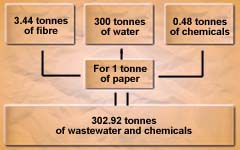
Grasim Industries Ltd opened a rayon pulp plant in 1963 along the river Chaliyar at Mavoor, district Kozhikode, Kerala. It produces rayon-grade pulp entirely based on bamboo
and wood for raw materials. Pulp from the Mavoor Plant fed Grasim Plants elsewhere owned by A.V Birla group.
Within months, toxic effluents including heavy metals such as mercury were discharged untreated into the river causing hundreds of fish to die. A health survey conducted
in the village of Vazhakkad, which receives much of the air pollution, revealed that 199 persons died of cancer between 1989 and 1994. Villagers are dying of cancer, asthma, cardiac arrest and chronic bronchitis around the plant, it said.
A report by CSE (Centre for science and Environment) read as under (excerpts)

"The mill claims that it has an environmental policy statement, though no document has been provided to substantiate the same. The fact that the mill is not aware of the
details of the policy raises the possibility that there is no policy or if it is there, it is for namesake. Grasim claims to have an environment department that is clubbed with the research and development wing. The department is shown to have 73 employees,
which seems to be very high. The mill’s resource consumption is marginally lower than other Indian rayon-grade pulp plants. It has revealed no documented policy on waste management or relations with local communities. Its pollution control equipment is rated
as average. The mill has a chemical recovery system and a kiln to recover lime from sludge. The company has not furnished any documented policy on adopting cleaner technology.
But areas where Grasim seems to have performed particularly poorly is water and chemical consumption. While the Indian worst average per unit water consumption stands at
200 tonnes, Grasim uses a whopping 300 tonnes of water to produce one tonne of paper. The mill is still using substantial amount of chlorine-based chemicals. It has to be noted that it is possible to bring down the figure to almost zero kg.
This makes a few things clear. The company uses a large amount of water and chemicals to produce a small amount of products. And it discharges the effluent into the river,
downstream of its uptake point. Moreover, as the Kerala Pollution Control Board (KPCB) points out, the factory does not even meet the stipulated standard for effluents. The figures indicate that the factory must be polluting the river. And that is just what
the local community complains about. They point to a rise in incidence of cancer and respiratory diseases in the region due to pollution caused by the factory.
Grasim’s fibre-use efficiency is quite low. But what is worse, the company’s water and chemical consumption is very high. Inefficiency is the other word for pollution."
Scientific studies indicated that concentrations of some toxic heavy metals were above the acceptable levels in the river beyond Chungapally, 6 km downstream of Mavoor,
where the factory discharged its effluent, clearly pointing the finger of suspicion at the factory.
Chaliyar was the lifeline of six serene paddy and coconut growing hamlets. Its people led by a cancer victim started one of the earliest known environmental agitation in
Kerala. Hunger strikes, labour strikes and lockouts plagued the plant. At least two video films were produced by activists to bring the plight of the people to the attention of the outside world. "Chaliyar-The
final Struggle" won a prize at the Mumbai International Film festival 2000. ( Click
here to read about this film). 'Unquiet flows the Chaliyar' was another video screened at the festival, again on the same theme.
On 30th June 2001, the factory was closed down and compensations paid to all its workers. The same year 'Birla White' another Birla Company became the first Indian Company
to achieve International Environmental Rating System Level 5 for excellence in Environmental Management.
Who is going to clean up the Chaliyar river? This is a question which remains unanswered.
By Susan Sharma
susan_sharma@hotmail.com